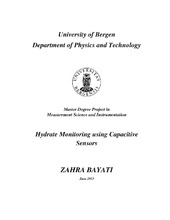Hydrate Monitoring using Capacitive Sensors
Master thesis
Permanent lenke
https://hdl.handle.net/1956/6806Utgivelsesdato
2013-06-02Metadata
Vis full innførselSamlinger
Sammendrag
Gas hydrates are of particular interest in petroleum industry since their formation during oil-production can be a major risk factor. Gas hydrates can block pipelines, interrupt production, and in worst case even cause bursting flow lines. There are a few strategies available to monitor the hydrocarbon flow in pipelines in order to give an early warning system against hydrate formation. A potential technique is to monitor changes in the dielectric properties of the flow, and relate these to hydrate formation. There is however a need for a dielectric measurement technique which can perform bulk permittivity measurements to detect gas hydrate formation. This is because gas hydrate formation is not always a homogenous process, and it can take place in the bulk phase of a multiphase flow. A potential technique for bulk permittivity measurements is based on capacitance measurement methods. This thesis studies the feasibility of using the capacitance sensing technique to monitor the formation of gas hydrates. To achieve this goal, a non-intrusive capacitance measurement system prototype has been designed, constructed, and tested under varying operating conditions. The COMSOL Multiphysics software tool has been used to determine an appropriate sensor design configurations of a capacitance sensor prototype. The design configurations are subsequently utilized for the construction of an experimental capacitance sensor. Finally, the ability of the capacitance sensor to identify permittivity changes during gas hydrate formation is experimentally investigated. To do so, the temperature and capacitance of two hydrate-forming test-samples with different water fractions have been measured in the kHz frequency range. The measured capacitance data was then used to find the permittivity information of the sample using capacitance sensor calibration curves. By following the measured permittivity and temperature variations of the hydrate-forming samples as a function of time, it is shown that the information derived from the capacitance sensor can be an indication of different stages of hydrate generation and evolution, for instance, (i) the onset and completion of the hydrate generation, (ii) phase inversion in the hydrate forming sample, and (iii) the permittivity relaxation related to the hydrate generation. This study verifies that permittivity measurements with these types of sensors can be used to monitor the generation of gas hydrates. Although important information about formation of gas hydrates can be obtained from the measured permittivity, no industrial applications of the capacitance sensors in the field of gas hydrate characterization have been reported so far. In addition, correlating the measured changes in dielectric parameters to the gas hydrate formation requires more analytical work.
